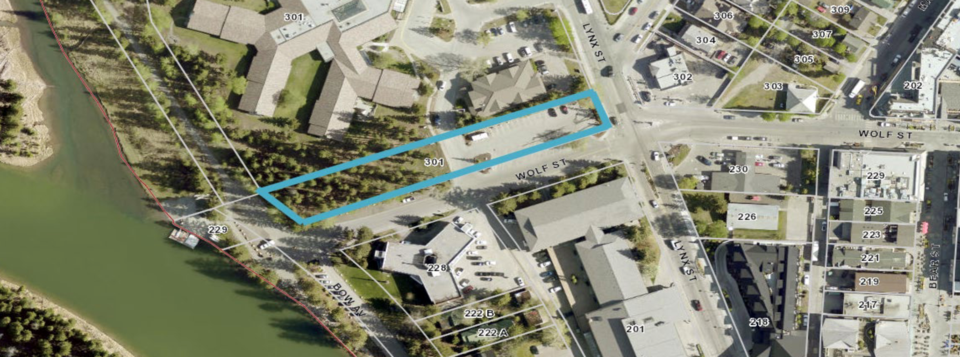BANFF – The Town of Banff is considering an affordable housing development on municipally owned land next to Mineral Springs Hospital and the provincial health unit.
At the next council meeting on Monday, May 13, administration will ask council for permission to go ahead with a site analysis, including geotechnical investigation, site survey, civil engineering work, and site pre-designs for construction of a mixed-use development of rental and for-purchase homes at 301 Wolf Street.
Part of the land, which is currently zoned public service, is a forested area by the Bow River while the other part is currently a paid parking lot.
Town of Banff officials say proposed changes to the land use bylaw to density, parking, and height, if approved by council, would allow the Town of Banff to maximize the density on this site and create a highly desirable development within the community core.
“This centrally located, Town-owned land parcel that may be appropriate to help address the unit shortfall and cost of living issues currently experienced by residents in Banff,” said Sharon Oakley, the Town’s housing sustainability manager in a report going to council on May 13.
The initial $110,000 cost for the site analysis would be funded through the Housing Accelerator Fund (HAF). Banff received $4.6 million through the multi-billion federal government initiative launched in 2023 to get more housing built across the country.
“Based on the HAF funding agreement, the Town of Banff is required to develop 43 affordable housing units by March 2027,” said Oakley.
The current zoning on this Wolf Street site allows for a combination of public service amenities on the ground floor, such as community services programming, government, or educational, and could be developed with a mixed-use housing development above.
However, Oakley said with the land use bylaw review, a discretionary use may permit housing on all levels of the development with the provision of below-market housing, but both options could be further explored at council’s direction.
“The final unit count will not be determined until the full analysis has been completed; however, it is anticipated that between 40-50 units may be possible on this site, depending on any changes made to the Land Use Bylaw,” she said.
Last year, council gave direction to administration to explore the feasibility of developing the Tatanga Ridge benchlands site for an affordable housing development, with the hopes of creating a 250-unit project for rental and for-purchase homes.
However, Oakley said a preliminary investigation of the site suggests the development of roads to access the land parcel includes significant costs and would need an agreement for access.
“The preliminary site investigation has indicated that due to the intricacies associated with the road access, an affordable housing development in this area is not likely to be completed within the time frames outlined in the HAF agreement,” she said.
Banff’s current housing shortfall is estimated to be 700 and 1,000 units.




